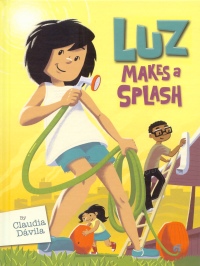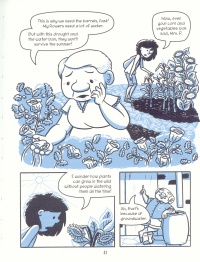| ________________
CM . . . . Volume XIX Number 11 . . . . November 16, 2012
excerpt:
The illustrations are simplified line drawings in black, white and blue. Characters are well-differentiated and emotions are clearly represented. There are several diagrams explaining concepts like groundwater and showing a very simplified version of how a greywater treatment system works; these are easy to understand and are integrated well into the flow of panels. The drying up of Spring Pond is not immediately obvious in the drawing, but this is the only panel that is less than perfectly clear. Otherwise, the art is engaging and serves the story well. The plot is simple and exists only to convey the message. There is a subplot about Luz feeling abandoned by her friends that feels contrived. The story is most effective when it uses the various characters to dramatize the effects of unsustainable habits and the attitudes that make change difficult. At times, the story feels heavy-handed, but humour and fun illustrations will keep readers involved. Young readers will feel empowered by the accessible ideas presented. Highly Recommended. Kim Aippersbach, a freelance editor and writer with three children, resides in Vancouver, BC.
To comment
on this title or this review, send mail to cm@umanitoba.ca.
Copyright © the Manitoba Library Association. Reproduction for personal
use is permitted only if this copyright notice is maintained. Any
other reproduction is prohibited without permission.
NEXT REVIEW |
TABLE OF CONTENTS FOR THIS ISSUE
- November 16, 2012.
AUTHORS |
TITLES |
MEDIA REVIEWS |
PROFILES |
BACK ISSUES |
SEARCH |
CMARCHIVE |
HOME |

 Luz Makes a Splash is the second book in Dávila’s series of graphic novels presented in a cartoon-like style and containing an environmental message, with the first being
Luz Makes a Splash is the second book in Dávila’s series of graphic novels presented in a cartoon-like style and containing an environmental message, with the first being